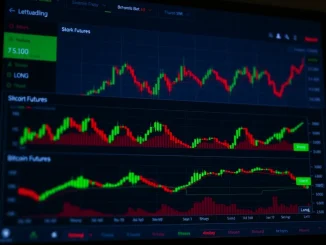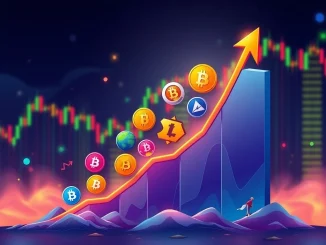
In the fast-paced world of cryptocurrency, understanding market sentiment is paramount for making informed trading decisions. One of the most insightful indicators for gauging the mood of the market, particularly among professional traders, is the long-short ratio for BTC perpetual futures. This metric provides a real-time snapshot of whether traders are predominantly betting on price increases (longs) or decreases (shorts) on Bitcoin’s future price. Today, we delve into the latest 24-hour data to uncover what the market is truly thinking.
Decoding the Long-Short Ratio: What Does It Tell Us?
At its core, the long-short ratio is a simple yet powerful indicator. It represents the proportion of long positions (bets on price increases) versus short positions (bets on price decreases) held by traders on a specific asset, in this case, Bitcoin (BTC) via perpetual futures contracts. These contracts are a popular instrument in derivatives trading, allowing traders to speculate on price movements without owning the underlying asset.
- Ratio above 1 (e.g., 1.2): Indicates more long positions than short positions, suggesting a bullish sentiment.
- Ratio below 1 (e.g., 0.8): Indicates more short positions than long positions, suggesting a bearish sentiment.
- Ratio around 1: Suggests a relatively balanced market sentiment.
Monitoring this ratio gives traders a pulse on collective market expectations, helping them anticipate potential price shifts or confirm existing trends. It’s a key piece of Bitcoin futures data that savvy traders keep a close eye on.
Why BTC Perpetual Futures Ratios are Crucial for Traders
The significance of BTC perpetual futures ratios extends beyond simple sentiment gauging. They offer a window into the leveraged positions that can amplify market movements. When a large number of traders are heavily biased in one direction, it can create conditions for a ‘short squeeze’ (if too many shorts are forced to cover) or a ‘long squeeze’ (if too many longs are liquidated). These events can lead to rapid price swings, making the ratio an invaluable tool for risk management and opportunity identification.
Understanding these ratios helps traders:
- Gauge Market Overextension: Extreme ratios can signal an overheated market (too many longs) or an oversold market (too many shorts), potentially indicating a reversal point.
- Identify Liquidation Risks: High concentrations of positions in one direction can highlight areas where cascading liquidations might occur, leading to volatility.
- Confirm Trends: A consistently high long ratio during an uptrend can confirm bullish momentum, while a low ratio during a downtrend can confirm bearish pressure.
24-Hour Bitcoin Futures Data Breakdown: A Snapshot of Sentiment
Let’s examine the latest Bitcoin futures data for the past 24 hours across key exchanges. This data provides immediate insights into the prevailing crypto market sentiment.
24-Hour BTC Perpetual Futures Long-Short Ratios:
| Category/Exchange | Long Positions | Short Positions | Long-Short Ratio (Approx.) |
|---|---|---|---|
| Total Market | 49.21% | 50.79% | 0.97 |
| Binance | 48.93% | 51.07% | 0.96 |
| Gate.io | 50.92% | 49.08% | 1.04 |
| Bybit | 49.58% | 50.42% | 0.98 |
Interpreting Crypto Market Sentiment from the Data
The aggregated data shows a slight bearish lean across the total market, with 50.79% of positions being short compared to 49.21% long. This translates to a long-short ratio of approximately 0.97, indicating that overall, more traders are betting on a price decrease for BTC perpetual futures.
- Binance’s Stance: Binance, a leading exchange by volume, mirrors the overall market sentiment, showing a slightly stronger bearish bias with 51.07% shorts. This suggests a significant portion of the market expects further downside or is hedging existing spot positions.
- Gate.io’s Divergence: Interestingly, Gate.io stands out with a bullish majority, showing 50.92% long positions. This divergence could indicate a pockets of optimism or different trading strategies among its user base compared to the broader market.
- Bybit’s Neutral-Bearish Tilt: Bybit shows a similar lean to the total market, with a slight majority of shorts (50.42%). It suggests a cautious, slightly bearish outlook among its traders.
This snapshot highlights that while the overall sentiment is leaning bearish, there isn’t an overwhelming consensus, and some exchanges show differing perspectives. This mixed bag can often lead to choppy price action as bulls and bears contend for dominance.
Leveraging Bitcoin Futures Data for Strategic Trading
So, how can you use this Bitcoin futures data in your trading strategy? It’s important to remember that no single indicator provides a complete picture, but the long-short ratio is a powerful piece of the puzzle.
Consider the following strategies:
- Counter-Trend Trading: Extreme ratios can sometimes signal an impending reversal. For instance, if the ratio is overwhelmingly long, it might suggest an overbought market ripe for a correction. Conversely, an extremely low ratio (too many shorts) could precede a short squeeze.
- Confirmation of Trends: If the price is rising and the long-short ratio is also increasing, it confirms strong buying pressure. If the price is falling and the ratio is decreasing (more shorts), it confirms selling pressure.
- Spotting Divergences: Pay attention when the long-short ratio moves contrary to the price action. For example, if Bitcoin’s price is rising but the long-short ratio is decreasing, it could signal underlying weakness in the bullish trend.
- Identifying Liquidity Pools: Areas with high concentrations of long or short positions often become targets for ‘liquidation hunts’ by larger players, leading to sudden price drops or pumps to clear out leveraged positions.
Always combine this analysis with other technical indicators, such as volume, support/resistance levels, and candlestick patterns, for a more robust trading plan.
Navigating Derivatives Trading with Long-Short Insights
For those engaged in derivatives trading, particularly with BTC perpetual futures, the long-short ratio offers a crucial layer of insight. However, it’s not without its challenges and nuances:
- Whale Influence: Large institutional traders or ‘whales’ can significantly skew the ratio. Their positions might not always reflect organic retail sentiment.
- Lagging Indicator: While real-time, the ratio primarily reflects what has already been placed. Market conditions can change rapidly.
- Exchange Specifics: As seen with Gate.io, ratios can vary significantly between exchanges due to differing user bases, liquidity, and trading strategies. Always consider the context of the specific exchange.
- Not a Standalone Signal: Relying solely on the long-short ratio for trading decisions is risky. It should be used as a complementary tool alongside broader market analysis and risk management strategies.
By understanding these limitations, traders can better integrate long-short ratio analysis into their overall strategy, enhancing their decision-making process in the volatile crypto markets.
Conclusion: Mastering Market Sentiment for Smarter Trades
The long-short ratio for BTC perpetual futures is an indispensable tool for anyone serious about understanding crypto market sentiment and making informed decisions in derivatives trading. While the latest Bitcoin futures data suggests a slight bearish bias overall, the nuances across different exchanges highlight the complexity of market dynamics.
By diligently tracking these ratios, combining them with other analytical methods, and understanding their inherent limitations, traders can gain a significant edge. It’s about more than just knowing the numbers; it’s about interpreting what those numbers mean for the collective mindset of the market and how that might influence future price movements. Stay informed, stay strategic, and may your trades be ever in your favor!



